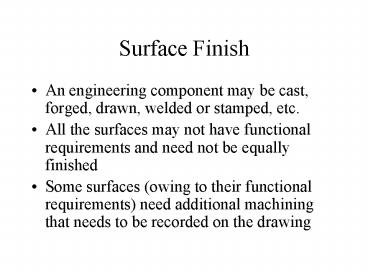Surface Finish - PowerPoint PPT Presentation
1 / 23
Title:
Surface Finish
Description:
... basic symbol consists of two legs of unequal length inclined at approximately ... The relation is given in following table. Machining Symbols ... – PowerPoint PPT presentation
Number of Views:992
Avg rating:3.0/5.0
Title: Surface Finish
1
Surface Finish
- An engineering component may be cast, forged,
drawn, welded or stamped, etc. - All the surfaces may not have functional
requirements and need not be equally finished - Some surfaces (owing to their functional
requirements) need additional machining that
needs to be recorded on the drawing
2
(No Transcript)
3
(No Transcript)
4
Surface Roughness
- The geometrical characteristics of a surface
include, - Macro-deviations,
- Surface waviness, and
- Micro-irregularities.
- The surface roughness is evaluated by the
height, Rt and mean roughness index Ra of the
micro-irregularities.
5
Surface roughness number
- Represents the average departure of the
surface from perfection over a prescribed
sampling length, (usually selected as 0.8 mm) - Surface roughness number (Ra) is expressed in
microns. - Ra (h1h2-----hn)/n
- The measurements are usually made along a line,
running at right angle to the general direction
of tool marks on the surface.
6
- Actual profile, Af
- It is the profile of the actual surface obtained
by finishing operation. - Reference profile, Rf
- It is the profile to which the irregularities of
the surface is referred to. it passes through the
highest point of the actual profile. - Datum profile, Df
- It is the profile, parallel to the reference
profile .it passes through the lowest point B of
the actual profile
7
- Mean Profile, Mf
- It is that profile, within the sampling length
chosen (L) such that the sum of the
material-filled areas enclosed above it by the
actual profile is equal to the sum of the
material void area enclosed below it by the
profile. - Peak to valley height, Rt
- It is the distance from the datum profile to the
reference profile. - Mean roughness index, Ra
- It is the arithmetic mean of the absolute value
of the highest hi between the actual and mean
profile. - Ra 1/L ?x0 hi dx , where L is sampling
length
xL
8
Surface Roughness expected from manufacturing
processes
9
Surface Roughness expected from manufacturing
processes
10
Measurement of roughness
- The roughness may be measured, using any of the
following - Straight edge
- Surface gauge
- Optical flat
- Tool markers microscope
- Profilometer
- Profilograph
- Talysurf
11
Basic symbol only be used alone when its
meaning is explained by a note
12
Roughness a obtained by any production process
Roughness a obtained by removal of material by
machining
Roughness a shall be obtained without removal of
any material
13
If it is required that the required surface
texture be produced by one particular production
method, this method shall be indicated in
plain language on an extension of the longer arm
of the symbol
Indication of machining allowance where it is
necessary to specify the value of the machining
allowance, this shall be indicated on the left of
the symbols. This value shall be expressed in
millimeters.
14
Generally to indicate the surface roughness, the
symbol is used instead of value. The relation is
given in following table.
15
Machining Symbols
This symbol may also be used in a drawing,
relating to a production process , to indicate
that a surface is to be left in the state
,resulting from a preceding manufacturing
process, whether this state was achieved by
removal of material or otherwise
16
Position of the Specifications of the Surface
Texture in the Symbol - The specifications Of
surface texture shall be placed relative to the
symbol as shown in figure.
17
(No Transcript)
18
Symbols with Additional Indications.
19
(No Transcript)
20
Ways to represent roughness
21
(No Transcript)
22
Separate note is written
23
Surface finish grades specified































